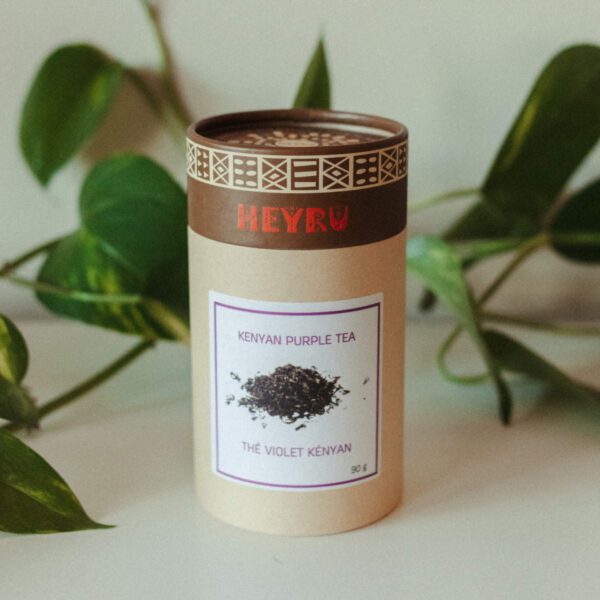Purple Tea: History and Origin
Purple tea is a relatively newcomer to the tea scene. The history of purple tea begins with the first plant mutation which was observed at the Assam tea gardens in India. The Tea Research Foundation of Kenya (TRFK) then started to research purple tea in the hopes that a variety of the tea plant would have suitable growing conditions there. Its cultivation began in the early 1980s and finally, in 2011, the seedlings were made commercially available to small scale farmers in Kenya. Kenya has been developing its own purple tea for the last 25 years.
Purple tea is grown in colder conditions, at a high altitude of between 4,500 and 7,500 feet. Consequently, the perfect place to grow purple tea is the Nandi Hills in Kenya due to their high elevation and good whether conditions. Similar to many other teas, such as black, green, and white, purple tea originates from the camellia sinensis plant. The major difference between purple tea and others is the method in which it is processed. The processing of purple tea is quite particular in order to savor its benefits.
The Processing method
The plucking standards of the leaves are strict and are monitored closely to ensure the best leaf is used in production. The leaves are transferred to a factory and are slightly withered (i.e. dried). Then they are immediately moved to a Panning process to stop the oxidation. A vital difference of purple tea is that it is not oxidized meaning that they are not exposed to air after they are harvested. The oxidation process determines the type of tea that will be produced and its color. For example, black teas are fully oxidized while green teas are only slightly oxidized. Then the purple leaves are rolled which is done by a machine in small batches and finally they are dried.

Purple Tea Benefits: Antioxidants
Purple Tea flourishes naturally near the equator in Kenya and is grown at extremely high elevations of 6,000 plus feet, which results in strong antioxidant properties. Purple tea has high levels of antioxidants, containing almost twice as many than other types of teas. A particular antioxidant that is present in purple tea is called anthocyanin, which is more than 400 times greater than in green tea leaves. High antioxidants, flavonoids, and peptides help the body to neutralize free radical, strengthen the immune system, and can provide a natural remedy for a wide range of health issues.
Health Benefits of Purple Tea
Purple tea has exhibited promising memory-enhancing effects and help against neurodegenerative diseases such as amnesia and dementia. Purple tea can help decrease stress and anxiety. It also has a lower caffeine content when compared to black and green tea, due to which it acts as an excellent calmative agent while decreasing blood pressure and heart rate. The tea can help to regulate blood sugar levels, speed up the metabolism which can help with weight loss, fight inflammation, and support a healthy immune system.
How to Prepare Purple Tea?
Purple tea can be brewed in various methods, Including using a tea pot, Tea Filter Bags, or The Wall Tea Infuser. Add 1-2 teaspoons of tea to one cup of boiling water. Let the tea infuse for 2-3 minutes, this allows the leaves to expand and produce a rich and flavorful taste. Although very pleasant in taste already, you can add honey or Monk Fruit Sweetener according to your liking. A great tip we suggest is adding a few Hibiscus Flower Leaves to compliment the tea and give a nice pop of flavor. Generally, purple tea is mild in flavor, with floral notes, and adding a lemon slice brings the purple color to life.
Check out our video to follow along: https://www.youtube.com/watch?v=3aWW-3-vFUg
-
 Kenyan Purple Tea 90g$17.99
Kenyan Purple Tea 90g$17.99 -
 Biodegradable Tea Filter Bags 50pcs$9.99
Biodegradable Tea Filter Bags 50pcs$9.99 -
 The Wall Tea Infuser$29.99
The Wall Tea Infuser$29.99
References
Lin YC, Lu HF, Chen JC, Huang HC, Chen YH, Su YS, Tung CY, Huang C. Purple-leaf tea (Camellia sinensis L.) ameliorates high-fat diet induced obesity and metabolic disorder through the modulation of the gut microbiota in mice. BMC Complement Med Ther. 2020 Dec 10;20(1):376. doi: 10.1186/s12906-020-03171-4. PMID: 33302947; PMCID: PMC7727182.
Kilel, A.K. Faraj, J.K. Wanyoko, F.N. Wachira, V. Mwingirwa, Green tea from purple leaf colored tea clones in Kenya- their quality characteristics, Food Chemistry, Volume 141, Issue 2, 2013, Pages 769-775.
Khan, F., Bashir, A., & Mughairbi, F. A. (2018). Purple Tea Composition and Inhibitory Effect of Anthocyanin-Rich Extract on Cancer Cell Proliferation. Medicinal & Aromatic Plants, 07(06). https://doi.org/10.4172/2167-0412.1000322 Retrieved from: https://www.longdom.org/open-access/purple-tea-composition-and-inhibitory-effect-of-anthocyaninrich-extracton-cancer-cell-proliferation-2167-0412-1000322.pdf





